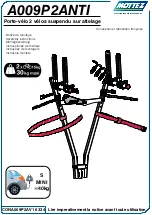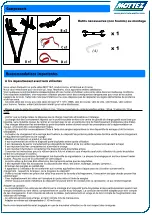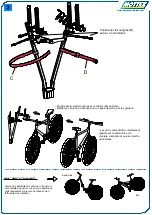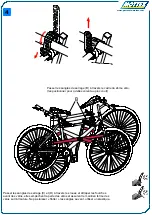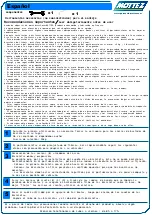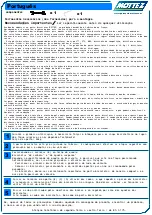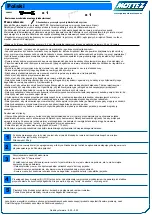
Must be read before use
Important information
Thank you for choosing MOTTEZ cycle carrier, a product designed and manufactured in France,Erquinghem-lys (59). We
hope you will be satisfied with it.
It is essential that you read these instructions before use.
- Incorrect installation or use can result in danger for you and others for which you may be held liable.
- For the safety of you and other users and to limit your liability, read the instructions carefully; they are not
meant to be exhaustive and do not absolve you from your duty to respect basic common sense rules.
- This cycle carrier is designed for all types of bikes except for electric bikes.
- Carrier weight 5.3 kg / Maximum permitted load on cycle carrier is 30 kg / 2 bicycles.
- Always check the maximum static load S permissible on the tow bar.
- The bicycles must be distributed correctly on the cycle carrier and as close to the vehicle as possible. The
centre ofgravity of the assemblymust be as low as possible, without the bicycle being able to touch the ground when
passing over an obstacle (speed bumps, etc.).
- Loads sticking out beyond the cycle carrier must comply with the current regulations, and must be appropriately
fixed. It is the user’s responsibility to comply with the standards applying in each country where the carrier is
used.
- Bicycle must be suitably fixed using the suitable straps and the red securing strap.
- It is recommended that you remove the cycle carrier after use in order not to inconvenience pedestrians or other
motorists.
- Every time the cycle carrier is used, check before departure and regularly during the journey that everything is
firmly secured (screws, knobs, straps, etc.).
- The fixings for the bicycles and the cycle carrier must be checked after fitting and regularly during the journey.
Re-tighten if necessary.
- Check that bicycle components are properly secured (wheels, saddle, etc.). You must also remove detachable
accessories from bicycles (drinks bottle, removable lights, pump, etc.).
- Keep and maintain the cycle carrier in good condition, store it suitably, rolling up the straps.
- Keep these instructions in your vehicle and ensure that they are read by any person who uses this cyclecarrier or
drives the vehicle while it is fitted.
- The number plate, lights and indicators must remain visible. If they are partially obscured, a lighting board must
be fitted. Your number plate must comply with the Highway Code.
- The cycle carrier may only be used for transporting bicycles.
- Look after the straps and only use them if they are in a perfect condition.
- Ensure that cycletyresare not too close to the vehicle exhaust, hot gases could damage them.
- Ensure that none of the unit´s metal parts come into contact with the vehicle´s bodywork, as they could damage it.
Adapt your driving:
- Your vehicle is now longer and wider, take this into account when manoeuvring.
- Reduce your speed (110 km/h maximum), especially when turning or passing obstacles and be aware of increased
braking distances. Take also into account the increased sensitivity to lateral wind.
- Do not use the cycle carrier on bumpy terrain: excessive shaking could damage your cycle carrier and your vehicle.
YOU ALONE ARE RESPONSIBLE FOR INCORRECT USE OR FAILURE TO FOLLOW INSTRUCTIONS.
components
Tools required (not supplied) for assembly
The cycle carrier is factory pre-adjusted. You MUST carefully carry out the following step to
adjust it to your vehicle.
Positions 1 or 2 will allow a better tightening on the tow ball
www.portevelo-mottez.com
x 1
When fitting it for the first time, you must feel some resistance to ensure optimum tightening.
Clamping force= 50kg
1
2
3
4
English
- Position the first bicycle with the chain facing towards the vehicle.
- Fit the bicycles alternately facing in the opposite direction, so that the handlebars do not
damage each other.
- The bicycles must be distributed correctly on the cycle carrier, and as close to the vehicle as
possible.
"Step through" and "suspension" frames
Some bike frames may not fit horizontally on the carrier but this in no way affects the
effectiveness of the fixing. You may use false cross bars to better position the bike on the
carrier.
Pass the bike securing straps (B) through the 2nd bike frame (secure them at the shortest
position).
It is essential to pass the bike securing straps (C) (D) through all the wheels and around the
front forks, they ensure that the bicycles aresecured firmly on the carrier.
Do not allow the straps to flap in the wind. Roll them up and tighten with a rubber band.
Available Monday to Friday: from 8.00am to 5.00pm.
x 1
5
This product has been carefully designed and manufactured. However, if youhave a problem, please
contact our customer service.
Guide the cable lock through the connecting rod then over the bicycle frames.
This will prevent the bicycles and the carrier from being stolen.
Summary of Contents for A009P2ANTI
Page 2: ...4...

